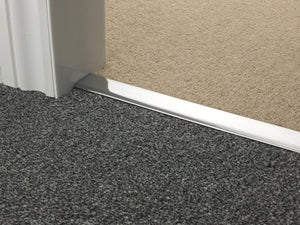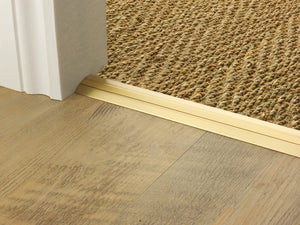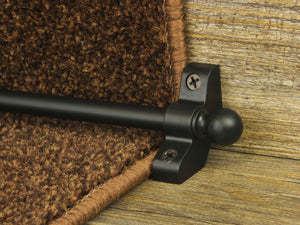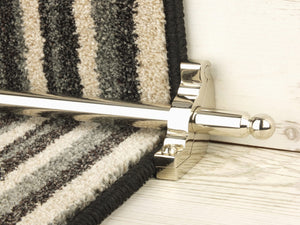How to Fit Stair Rods
A step-by-step guide to ensure a smart and secure fit
Fitting stair rods to a carpeted staircase has become a popular project for homeowners looking to bring some style and focus to the centre of their home. Whether you fit stair-rods retrospectively to an existing stair carpet or at the same time as your new stair carpet goes down, the job is straightforward and relatively simple.
To determine the correct length of rod to order, check out our guide on how to measure up. We also include comprehensive information on our stair rod product pages, whichever stair rod design you decide to purchase.
Stair carpet rods are purely for decoration
Remember, your carpet runner should be attached securely to the staircase by some means other than your staircase rods. When stair rods were first invented back in the 19th century they were designed to hold the runner in place, but in reality the runner would gradually slip down the staircase and rucks would appear and the carpet would wear unevenly. Today, a carpet runner is instead typically fitted with gripper along the edges of the stair tread and the stair rods are therefore purely decorative.
First determine the type of carpet rods you are installing
Before starting to fit stair rods to your staircase, do first check you have the correct type of fittings and length of rods. Otherwise, you will run into difficulties. There are three types as illustrated in the picture below: Front Fix, Runner and Side Fix. By far the most popular is the Runner carpet rod option.

A. How to fit Runner stair rods
The best quality stair rod brackets are hinged and made of solid brass and finished to match the stair rod. Each one is supplied in two sections and slots together. These are supplied with ranges such as the Premier rod design, Vision and Country, which are all made-to-measure carpet rod designs. A good quality bracket will lift the stairrod high enough away from the step to cope with a decent thickness of pile and underlay. Be careful, some of the cheaper ranges on the market come with brackets that are so thin that the thickness of the carpet and underlay bends the rod.

Fixing runner stair rods for the Crystal, Country, Eastern Promise, Premier, Vision ranges:
If you have chosen the “Runner” style of bracket, then your brackets will sit either side of your runner and you attach them to the staircase. Each rod is supplied with a pair of hinged brackets and screws. The top and bottom section of each bracket are a pair and should not be muddled up with other brackets.
- Fit the carpet runner first.
- Start at the bottom of your staircase.
- Ease each bracket apart by taking out the dome-headed screw and sliding apart using your fingers.
- Place the bottom part of each pair of brackets either side of the runner, adjacent to the carpet edge and in the angle where the tread joins the riser.
- Drill a pilot hole: 2.5mm for softwood, 3mm for hardwood and then a 4 mm clearance hole for the screw. Attach screw, making sure you use a low torque to avoid breaking the screw.
- Take your stair rod and place it centrally across the bottom brackets, making sure you have the same amount of over-hang on both sides.
- Attach the top section of the brackets and screw in dome-headed screw, which will be visible.
Fixing runner stair rods for the Blacksmith, Royale and Tudor ranges of carpet rods:
These styles of stair rods are supplied with a pair of matching, unhinged brackets and matching screws. The brackets are attached to the staircase, either side of the runner. Follow instruction (5) above and slide in the rod.
Fixing runner rods for Jubilee and Homepride stair rods:
For the off-the-shelf Jubilee and Homepride stair rods, the brackets are attached to the finial ends of the stair rods, whilst the rod section is separate. This means you can cut the rod down to suit your runner. Fix in place, either side of your runner, following the advice provided in (5) above for the top and bottom bracket holes.
B. How to fit Front Fix rods for a fitted stair carpet
The brackets are half-cup in shape and just fit over the front of the rod and fix through the fitted stair carpet and underlay.
C. How to fit Side Fix Rods for a fitted stair carpet
Side Fix Rods are relevant if you have a fully fitted stair carpet which covers the complete width of the steps. The rod has no decorative finial end as it runs across the full width of the stiracse. As the name suggests, these brackets fit to both sides or the stringboard running up the sides of your staircase. Follow the advice (5) above when attaching them.
D. How to fit stair rods to a winding stairs
If your staircase is winding or spiral, it is easiest to use a stair rod design with a universal bracket, such as the Blacksmith. These brackets can be easily fitted at a slight angle, which is ideal. If your brackets are standard Runner brackets, like those supplied with the Premier or Vision stair rod designs (see above), then you will need to fit them at a slight angle, working out each step individually.





